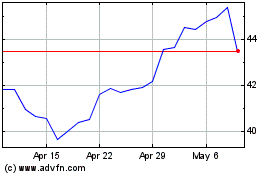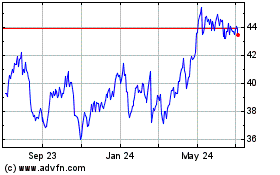By Mia Lamar
A little-known Singapore hedge fund run by a former professor
and an ex-actuary is quietly earning some of the world's top
returns with a sometimes stomach-churning strategy that piles on
risk.
Quantedge Capital Pte Ltd's hedge fund has gained 40% after fees
this year as of June, making it the second-best-performing fund in
2016 in a ranking of more than 350 hedge funds that HSBC Holdings
PLC compiles and sends to clients.
The fund gained an estimated 12% in June alone, according to a
letter sent to investors and seen by The Wall Street Journal.
Bond-related investments led the June gain, offsetting losses on
stocks as markets "swung wildly" following Britain's decision to
leave the European Union, the letter said.
In an emailed response to questions, the fund said that holding
riskier longer-term bonds while betting against short-term bonds--a
"term premium" strategy that tends to rise in times of market
distress--has been among its profitable bets this year.
Over the long term, which is how many investors evaluate funds,
the $1.3 billion fund has produced an average annualized return of
27% since inception, far more than similar hedge funds. Quantedge
started trading in late 2006 with $3 million, according to
marketing documents seen by the Journal.
The fund's nearly decadelong history makes it one of the
longest-running--and most successful--"risk premia" investors, an
approach that has been the focus of an increasing number of new
fund offerings.
Thierry Roncalli, head of quantitative research at Société
Générale's Lyxor Asset Management unit, said this type of strategy
appeals to sophisticated, long-term investors looking to earn a
return in an era of low interest rates and low expected returns on
traditional assets.
"You have to take some risk. This is not a magic formula," Mr.
Roncalli said. "It would be very interesting if we found a
portfolio which is well rewarded and has limited risk."
Unlike stock or bond funds that build portfolios around a
specific class of assets, such funds build portfolios around
specific risks, such as owning illiquid, harder-to-trade stocks
versus easier-to-trade stocks, or owning riskier long-term debt
versus short-term debt.
Such strategies seek to profit by collecting the excess
returns--or risk premia--that are typically expected from riskier
bets to compensate investors for the greater chance of losses.
Quantedge has a sprawling portfolio compared to many similar
investors, using automated computer programs to shift between some
combination of over 100 such positions at any time in everything
from commodity to bond markets, the fund said in its emailed
response.
For the term premium strategy, for example, the fund may short,
or bet against, three-month Treasury bills while going long, or
betting on gains, for 10-year Treasury notes.
The approach takes a page from the endowment model of investing
made famous by Yale University, which also seeks to profit over the
long run with a high stake in riskier investments.
Quantedge adds a tweak that can be dangerous. Many investors
raise and reduce risk in their portfolios as they change their
positions. That helps them to avoid sharp, sudden losses in times
of market fear but can also mean they are slower to profit when
markets rebound.
Quantedge, by comparison, maintains a common measure of risk
known as annualized volatility at a constant and abnormally high
level of 30%, two to three times that sought by similar hedge
funds, according to investors.
That produces a higher chance for the fund to notch
above-average gains. It also raises the likelihood of a big loss,
and some investors say that the risk of investing in a
high-volatility fund like Quantedge is that losses get so high that
an investor pulls out of the fund at a big loss.
Earlier in its history, its risk target was even higher at 40%
annualized volatility, according to a 2012 marketing document seen
by the Journal.
"Our investment goal is to compound capital aggressively over
the long term at a level of volatility that our investors can
tolerate," the fund said in its emailed response.
AQR Capital Management LLC--founded by former University of
Chicago finance researchers--and Two Sigma Advisers LLC are among
firms that have rolled out new funds focused specifically on
reaping rewards from risk premia.
The outsize returns set the firm apart in a hedge-fund industry
that has struggled for several years with lackluster performance.
Since Quantedge started trading in October 2006, hedge funds
globally have produced an average annualized return of 3.61% as of
the end of June, according to data provided by fund tracker HFR
Inc.
Similar quantitative funds have produced an average annualized
return of 5% over the same period, according to HFR.
The firm doesn't boast the Wall Street background typical of
many hedge funds. One founder, Chua Choong Tze, previously worked
as a finance professor in Singapore. The other, Leow Kah Shin,
worked as an actuary in Bermuda, according to marketing
documents.
Quantedge's rich returns have come with some bumpy rides. This
was in display during last summer's global market selloff, when the
fund plunged 8.9% in June, and an additional 16% in August.
In an August letter to investors seen by the Journal, the fund
called its performance during the global market rout
"disappointing."
"To our longtime investors, who have been through a few
up-and-down cycles with us, you know this is business as usual," it
wrote. "...Our investment model delivers high returns over time, at
the cost of unpleasant bumps along the way."
Write to Mia Lamar at mia.lamar@wsj.com
(END) Dow Jones Newswires
July 20, 2016 05:53 ET (09:53 GMT)
Copyright (c) 2016 Dow Jones & Company, Inc.
HSBC (NYSE:HSBC)
Historical Stock Chart
From Mar 2024 to Apr 2024

HSBC (NYSE:HSBC)
Historical Stock Chart
From Apr 2023 to Apr 2024
